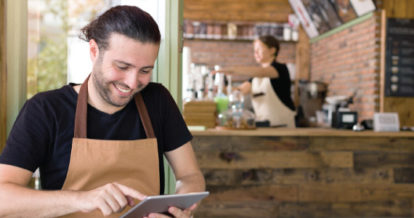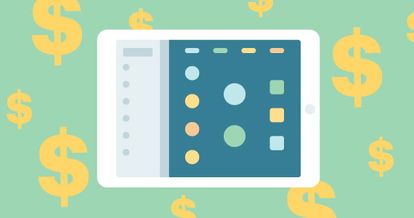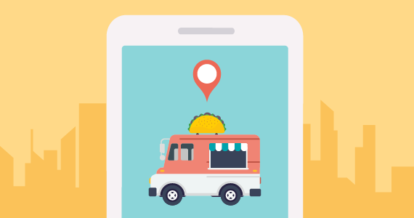Almost three quarters of restaurant owners surveyed in the latest research report on rising minimum wage, The State of Rising Minimum Wage for Restaurants, reported that their labor ratio is above 25%. While any labor ratio under 35% is considered “normal” for most restaurants, restaurant owners will need to be extra diligent to make sure their labor ratio stays healthy and doesn’t begin to eat away at profits. Smart restaurant owners are turning to technology to cope with increased labor costs.
Restaurant technologies like POS labor reports, staff scheduling software, and even robotics can help you make strategic decisions about labor. Here are five restaurant technologies to help you cope with rising restaurant minimum wage.

1. A Modern Point of Sale (POS)
A POS system is your restaurant’s transactional hub. Unlike old-school cash registers, today’s POS systems keep track of so much more than just purchases. Your POS can help you monitor various data points, process payments, manage inventory, and even keep track of labor. And if you use a cloud-based POS system with cloud reporting, you can receive real-time insights and have off-premise access.
How Can a POS System Help My Restaurant Cope with Rising Minimum Wage?
The real power of modern POS systems is in the data they provide restaurants owners and managers. Your POS can empower you with labor reports that will guide you through money-saving decisions.
While most restaurant owners with a POS have the ability to access these powerful labor reports, our research shows that a lot of restaurant owners (39%) are not using their POS to view labor reports.
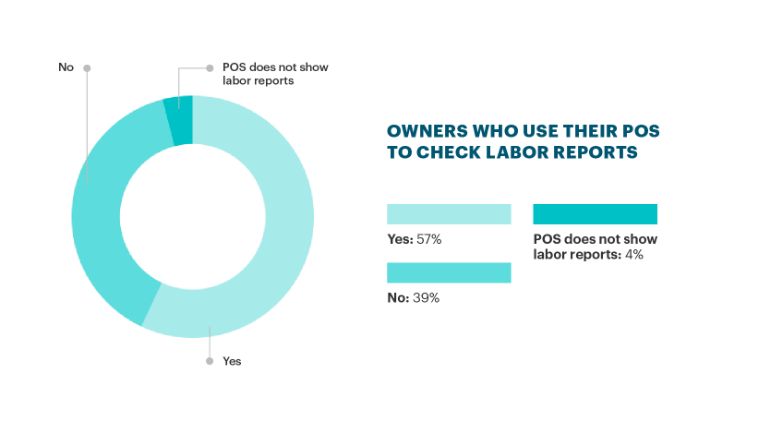
Restaurant owners and managers who don’t use data to make scheduling decisions are missing out on efficiencies that could save them significant costs. Your POS system’s labor reports can help you know:
- When you’re overstaffed. Your POS can show you how many staff members are working during slow hours. You can save money by reducing your kitchen’s hours during slow periods, correcting managers who wait too long to cut staff, and scheduling fewer staff members when you know you won’t have as many customers. For example, you may need fewer staff right at 5:00 pm, when customers are just getting in a drink order.
- Who your best servers are. With detailed shift and tip reports, you’ll be able to see which servers are upselling the most and making customers the happiest. This can help you make scheduling decisions for busy times or special events. Plus, if you ever have to cut down on wait staff, you’ll be able to make a strategic decision based on performance rather than emotions.
- Whether your staff are stealing from you. On the flip side, POS labor reports can also help you figure out if your front-of-house staff are doing a less than stellar job. Does one server delete items like it’s going out of style? Detailed deleted items and no sale reports can help you trace any fishy business back to the source so you can address the problem with data to back it up.
Added Benefits
Besides generating labor reports, a POS can help you:
- Save money on inventory by keeping track of what you have in stock
- Streamline operations through floor plan management
- Increase orders from customers through a loyalty program
2. Employee Scheduling Software
What Is Employee Scheduling Software?
Employee scheduling software helps restaurants plan, manage, and adjust staff schedules more efficiently. Instead of relying on spreadsheets, texts, or manual processes, scheduling tools centralize schedules and team communication in one place so employees and managers always have visibility into shifts and updates. When employee scheduling software is integrated with a POS system, it can also provide valuable insights into labor costs and staff performance, helping operators better understand how scheduling impacts the business.
How Can Employee Scheduling Software Help My Restaurant Cope with Rising Minimum Wage?
Rising minimum wage makes labor efficiency more important than ever. Employee scheduling software can help restaurants reduce overall labor costs by 1 to 3 percent by cutting down the time managers spend creating schedules and coordinating shift changes. Instead of calling, texting, or emailing employees back and forth, managers can handle scheduling and communication through a single platform, saving time and reducing administrative labor.
For restaurants still using pen and paper or spreadsheets, switching to a cloud-based scheduling solution can be a major improvement. Features like the ability to reuse existing schedules and scheduling automations help reduce errors, improve consistency, and simplify the weekly scheduling process.
Employee scheduling software can also help restaurants manage labor costs more strategically through labor forecasting. By combining sales data with staffing information, operators can schedule the right number of employees based on expected demand. With a POS integration, restaurants can track employee hours, wages, tips, and productivity in one system, making it easier to adjust staffing levels and make informed labor decisions as wages continue to rise.
3. Self-Ordering Kiosks
What Is a Self-Ordering Kiosk?
A self-ordering kiosk is a terminal that automates the customer ordering and payments process for restaurants. Customers can place their own orders on an easy-to-use interface so that your staff are free to focus on creating a great customer experience.
How Can a Self-Ordering Kiosk Help My Restaurant Cope With Rising Minimum Wage?
With minimum wage on the rise, you’ll want to know how and where your staff can have the most impact, while automating repetitive tasks. With a self-ordering kiosk, you can:
- Maximize your front-of-house staff. A self-ordering kiosk can automate the work of a cashier, freeing up your front-of-house team to focus on customer satisfaction rather than just taking orders.
- Bring in more revenue. Self-ordering kiosks come with several features to help you increase your sales while keeping labor costs down.
- With automated upselling, kiosks prompt customers to add upgrades, sides, and combos to their orders. Taco Bell, for instance, has made 20% more money on orders taken by their digital app, compared to those taken by human cashiers.
- The kiosk’s customizable interface makes it super easy to promote high-margin items by displaying them front and center, where they can’t be missed by customers.
- Unlike with printable menus, you can change menu prices daily on a self-ordering kiosk. You can use data from your kiosk to strategically increase prices of best-selling items or modify prices as the cost of ingredients rises.
Added Benefits
Self-ordering kiosks also let you:
- Reduce order errors because the customer is able to input the information themselves
- Customize the menu display for a seamless branding experience throughout your restaurant
4. Robotics for Restaurants and Foodservice
What Is Robotics and How Is it Used by Restaurants?
Robotics and automation are taking over restaurants around the world, automating everything from food delivery to cooking.
In Boston, MIT students created Spyce, a fast casual restaurant that uses robots to prepare each meal consistently and accurately in three minutes or less. Customers place orders on self-ordering kiosks and robots complete the meal. With Michelin-starred chef Daniel Boulud driving the menu, the necessary human touch is still there, but Spyce is able to keep labor costs low because their staff are machines.
Chicago dumpling hot spot Wow Bao has fully automated several of its restaurants with technology from Eatsa, a platform that combines self-ordering kiosks with Amazon locker-like cubbies that display a customer’s name when his or her order is complete.
How Can Robotics Help My Restaurant Cope with Rising Minimum Wage?
Cutting-edge restaurant technologies like robots and automated food cubbies can help you cope with rising minimum wage by decreasing human labor. While there are initial costs associated with installing such restaurant technologies, the technology quickly pays for itself by reducing labor costs.
You don’t have to replace all of your staff to save money on labor with robotics and automation. Choose one area to focus on and explore new technology that will complement your staff’s efforts, allowing them to be more productive.
With a full-service robotics solution for restaurants like Eatsa, you could greatly reduce both front-of-house and back-of-house staff through automated ordering and pick-up.
Added Benefits
In addition to reducing labor costs, introducing robotics to your restaurant comes with a ton of benefits that will make the initial investment seem like a steal when compared to the value.
- A faster customer experience. Whether you partially or fully automate your restaurant, automation can help you take orders and serve food faster, which lets you serve more customers and increase your bottom line.
- Publicity for your restaurant. As an early adopter of robotics, your phone will be ringing off the hook with inquiries from national and local media. You’ll also reap more benefits if you’re the first restaurant in your city to adopt such technology. In addition to publicity from traditional media, you’ll turn your customers into free publicists who share photos and videos from your restaurant on social media.
- Order consistency. With robots working the back of the house, your restaurant will be able to create a more consistent experience for all of its customers. With more consistency, happy customers will keep coming back because they know they can count on a similar experience each time they come to your restaurant.
- Reducing human error. Robotics can help reduce human error, creating satisfied customers time after time. From never missing an ingredient to honoring special requests accurately every time, robotics can help your restaurant save money on costly human mistakes.
5. Employee Incentive Program Technology
What Is Employee Incentive Program Technology?
Staff turnover is expensive for restaurants. Every time a staff member has to be replaced, time and money is spent on training someone new, taking away from resources that could be spent on promotion or improving your guest experience in some way.
You can also review your POS labor reports to understand your staff’s performance, and then reward your top employees with free meals, bonuses, or paid time off. Get creative!
How Can Employee Incentive Program Technology Help My Restaurant Cope with Rising Minimum Wage?
A study by Cornell’s Center for Hospitality Research found that from recruiting to productivity loss, staff turnover can cost hospitality businesses an average of almost $6,000 per person. Investing in current staff leads to labor savings over time because you’re not spending thousands on training new staff every few months.
Implementing employee incentive program technology can lead to greater talent retention, which leads to better service for guests, happier, returning customers, and, ultimately, a larger bottom line.
Software like Springzy incentivizes restaurant staff performance by creating contests between servers. You can assign point values for high-margin menu items, and reward your team for selling the most with prizes like digital gift cards.
Added Benefits
Employee Incentive Program Technology can also:
- Integrate with your POS
- Help staff track their performance in real time, motivating them to perform even better
Rising minimum wage is hitting the restaurant industry hard. When you’re operating at a profit margin of 10% or less, any increase to your labor ratio can feel like a harsh blow to your bottom line. Rather than firing staff or increasing prices, smart restaurateurs are turning to restaurant technologies to help offset rising labor costs. With a little research and creativity, you can find the right technology solutions that will be kind to your budget – and even kinder to your bottom line.
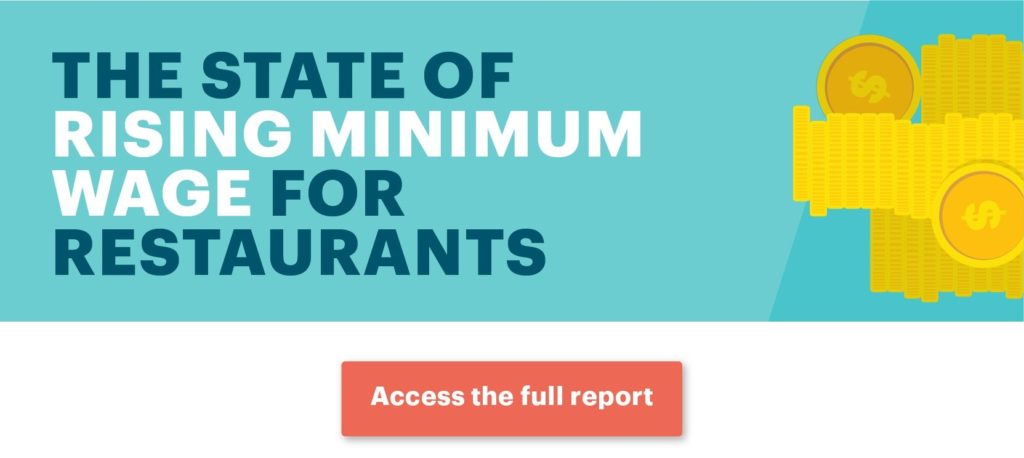
Get the Complete Guide to Restaurant Reservations
Sign up for our free weekly TouchBistro Newsletter

